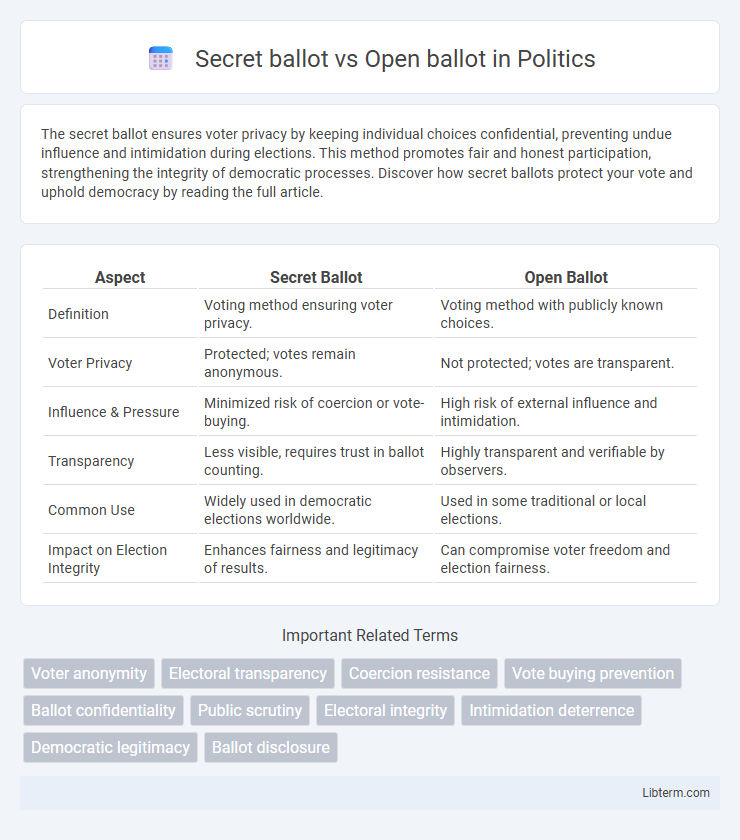The secret ballot ensures voter privacy by keeping individual choices confidential, preventing undue influence and intimidation during elections. This method promotes fair and honest participation, strengthening the integrity of democratic processes. Discover how secret ballots protect your vote and uphold democracy by reading the full article.
Table of Comparison
| Aspect | Secret Ballot | Open Ballot |
|---|---|---|
| Definition | Voting method ensuring voter privacy. | Voting method with publicly known choices. |
| Voter Privacy | Protected; votes remain anonymous. | Not protected; votes are transparent. |
| Influence & Pressure | Minimized risk of coercion or vote-buying. | High risk of external influence and intimidation. |
| Transparency | Less visible, requires trust in ballot counting. | Highly transparent and verifiable by observers. |
| Common Use | Widely used in democratic elections worldwide. | Used in some traditional or local elections. |
| Impact on Election Integrity | Enhances fairness and legitimacy of results. | Can compromise voter freedom and election fairness. |
Introduction to Voting Methods
Secret ballot voting ensures voter privacy by allowing individuals to cast their votes confidentially, which minimizes coercion and vote manipulation. Open ballot voting requires voters to announce their choices publicly, increasing transparency but risking voter intimidation and social pressure. Each method affects election integrity and voter behavior differently, shaping democratic processes worldwide.
Defining Secret Ballot
Secret ballot, also known as an Australian ballot, guarantees voter privacy by concealing individual choices from public view to prevent coercion and vote-buying. This method employs private booths and confidential ballots to ensure that electoral decisions remain anonymous, enhancing election integrity and voter confidence. In contrast, open ballot systems disclose voter selections publicly, which can expose voters to undue influence or intimidation.
Understanding Open Ballot
Open ballot voting involves voters publicly declaring their choices, which can influence transparency and accountability in elections but may also expose individuals to social pressure or intimidation. Unlike secret ballots, open ballots lack anonymity, potentially affecting voter behavior and election integrity. This voting method is often employed in small communities or organizational settings where transparency is prioritized over confidentiality.
Historical Evolution of Ballot Systems
The historical evolution of ballot systems reflects the transition from open ballots, where voters publicly declared choices, to secret ballots ensuring privacy and reducing coercion. The secret ballot, often called the Australian ballot after its 19th-century adoption in Australia, revolutionized electoral integrity by safeguarding voter anonymity and minimizing electoral fraud. This shift marked a significant milestone in democratizing elections and protecting individual voting rights globally.
Key Differences: Secret vs Open Ballot
The secret ballot ensures voter privacy by allowing individuals to cast votes confidentially, preventing coercion and vote buying, while the open ballot publicly reveals each voter's choice, enabling transparency but exposing voters to potential intimidation. Secret ballots utilize private voting booths or electronic systems that mask the vote identity, contrasting with open ballots where votes are declared aloud or marked publicly. Key differences include voter anonymity, susceptibility to manipulation, and the balance between confidentiality and transparency in electoral processes.
Pros and Cons of Secret Ballot
Secret ballot ensures voter privacy, reducing intimidation and coercion, thus promoting free and fair elections. However, it can complicate vote verification and transparency, sometimes leading to challenges in auditing election results. While protecting voter anonymity, secret ballots may also increase the risk of vote selling due to the lack of traceability.
Pros and Cons of Open Ballot
Open ballot systems enhance transparency by allowing voters' choices to be publicly known, which can deter electoral fraud and promote accountability among candidates. However, this lack of privacy can lead to voter intimidation, coercion, and social pressure, potentially compromising the freedom and authenticity of the vote. While open ballots facilitate straightforward vote counting and immediate results, they risk undermining voter confidence in the fairness of elections due to the absence of confidentiality.
Impact on Voter Privacy and Security
Secret ballots ensure voter privacy by concealing individual choices, preventing coercion or retaliation, and maintaining election integrity. Open ballots expose votes publicly, risking voter intimidation and compromising security through the potential manipulation of ballot information. Maintaining confidential voting protocols strengthens democratic processes by safeguarding voter anonymity and trust in electoral outcomes.
Global Usage and Legal Frameworks
Secret ballots are widely adopted in democratic countries worldwide, ensuring voter privacy and reducing coercion, as codified in international legal frameworks such as the Universal Declaration of Human Rights and the International Covenant on Civil and Political Rights. Open ballots, though less common, are still utilized in some regions for transparency in local elections or party votes, often regulated by national electoral laws that emphasize public accountability. The choice between secret and open ballots depends on balancing voter confidentiality with electoral openness, influenced by cultural, political, and legal contexts across different countries.
Choosing the Right Ballot System
Choosing the right ballot system depends on balancing voter privacy and transparency in elections. Secret ballots protect voter anonymity, reducing coercion and vote manipulation, while open ballots increase transparency but can expose voters to pressure or intimidation. Factors such as election type, cultural context, and the need for security should guide the decision between secret and open ballot systems.
Secret ballot Infographic

 libterm.com
libterm.com